Demonstrate ECM Extractors#
The ECM extractors assemble the required components for Equivalent Circuit model using reference performance test data.
[1]:
%matplotlib inline
from matplotlib import pyplot as plt
from battdat.data import BatteryDataset
import numpy as np
Load an Example Dataset#
We use an example RPT cycle from the CAMP 2023 dataset to demonstrate parameter extraction
[2]:
data = BatteryDataset.from_hdf('files/example-camp-rpt.h5')
[3]:
data.raw_data
[3]:
| cycle_number | file_number | test_time | state | current | voltage | step_index | method | substep_index | cycle_capacity | cycle_energy | |
|---|---|---|---|---|---|---|---|---|---|---|---|
| 0 | 1 | 0 | 120.042 | b'charging' | 0.260548 | 3.450065 | 0 | b'constant_current' | 0 | 0.000000 | 0.000000 |
| 1 | 1 | 0 | 139.182 | b'charging' | 0.260090 | 3.470207 | 0 | b'constant_current' | 0 | 0.001384 | 0.004789 |
| 2 | 1 | 0 | 439.182 | b'charging' | 0.260014 | 3.487297 | 0 | b'constant_current' | 0 | 0.023055 | 0.080177 |
| 3 | 1 | 0 | 739.182 | b'charging' | 0.259937 | 3.493553 | 0 | b'constant_current' | 0 | 0.044720 | 0.155796 |
| 4 | 1 | 0 | 1039.182 | b'charging' | 0.260166 | 3.499809 | 0 | b'constant_current' | 0 | 0.066391 | 0.231572 |
| ... | ... | ... | ... | ... | ... | ... | ... | ... | ... | ... | ... |
| 180 | 1 | 0 | 41767.320 | b'hold' | 0.000000 | 3.272145 | 3 | b'rest' | 8 | -0.027665 | 0.011427 |
| 181 | 1 | 0 | 41777.322 | b'hold' | 0.000000 | 3.276875 | 3 | b'rest' | 8 | -0.027665 | 0.011427 |
| 182 | 1 | 0 | 41787.318 | b'hold' | 0.000000 | 3.280995 | 3 | b'rest' | 8 | -0.027665 | 0.011427 |
| 183 | 1 | 0 | 41797.320 | b'hold' | 0.000000 | 3.284504 | 3 | b'rest' | 8 | -0.027665 | 0.011427 |
| 184 | 1 | 0 | 41807.310 | b'hold' | 0.000000 | 3.287556 | 3 | b'rest' | 8 | -0.027665 | 0.011427 |
185 rows × 11 columns
The dataset contain a single slow cycle that samples the entire capacity of the cell.
[4]:
fig, axs = plt.subplots(2, 1, figsize=(3.5, 3.), sharex=True)
raw_data = data.tables['raw_data']
time = (raw_data['test_time'] - raw_data['test_time'].min()) / 3600
axs[0].plot(time, raw_data['voltage'])
axs[0].set_ylabel('Voltage (V)')
axs[1].plot(time, raw_data['current'])
axs[1].set_ylabel('Current (A)')
axs[1].set_xlabel('Time (hr)')
[4]:
Text(0.5, 0, 'Time (hr)')
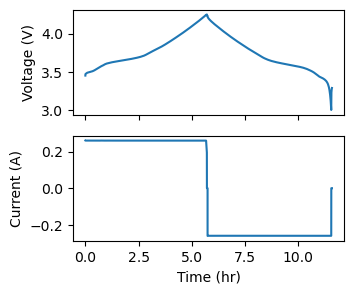
Determining Capacity#
The MaxCapacityExtractor determines capacity by integrating current over time then measuring difference between the maximum and minimum change in charge state.
Note: Integration is actually implemented in battdat.
[5]:
from moirae.extractors.ecm import MaxCapacityExtractor
[6]:
cap = MaxCapacityExtractor().extract(data)
cap
[6]:
MaxTheoreticalCapacity(updatable=set(), base_values=array([[1.48220808]]))
This should match up with the measured change in charge
[7]:
fig, ax = plt.subplots(figsize=(3.5, 2.))
ax.plot(time, raw_data['cycle_capacity'])
ax.set_xlim(ax.get_xlim())
ax.set_ylabel('Capacity Change (A-hr)')
ax.set_xlabel('Time (hr)')
min_cap, max_cap = raw_data['cycle_capacity'].min(), raw_data['cycle_capacity'].max()
ax.fill_between(ax.get_xlim(), min_cap, max_cap, alpha=0.5, color='red', edgecolor='none')
[7]:
<matplotlib.collections.FillBetweenPolyCollection at 0x74e1204de890>
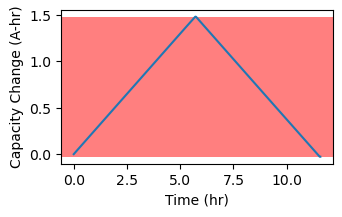
The width of the colored span is the estimated capacity and it spans from the lowest capacity (~11hr) and the highest (~6hr)
Open-Circuit Voltage Estimation#
The OCVExtractor determines the Open Circuit Voltage by fitting a spline to voltage as a function of state of charge.
The first step is to compute the SOC from the capacity change during the cycle and the total capacity estimated by MaxCapacityExtractor. As the actual state of charge cannot be directly measured, we assume the lowest capacity change is an SOC of 0.
[8]:
raw_data['soc'] = (raw_data['cycle_capacity'] - raw_data['cycle_capacity'].min()) / cap.base_values.item()
[9]:
fig, ax = plt.subplots(figsize=(3.5, 2.))
ax.plot(raw_data['soc'], raw_data['voltage'])
ax.set_ylabel('Voltage (V)')
ax.set_xlabel('SOC')
[9]:
Text(0.5, 0, 'SOC')
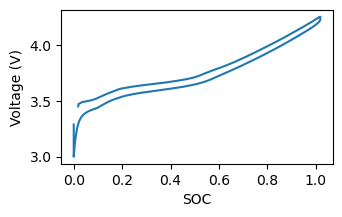
The voltage during charge and discharge are different. Moirae accounts for this by weighing points with lower current more strongly and fitting a smoothing spline.
Note: Make the spline fit data more closely by increating the number of SOC points
[10]:
from moirae.extractors.ecm import OCVExtractor
ocv = OCVExtractor(capacity=cap).extract(data)
[11]:
fig, ax = plt.subplots(figsize=(3.5, 2.))
ax.plot(raw_data['soc'], raw_data['voltage'], label='Data')
soc = np.linspace(0, 1, 64)
fit = ocv(soc)
ax.plot(soc, fit[0, :], 'r--', label='OCV')
ax.set_ylabel('Voltage (V)')
ax.set_xlabel('SOC')
ax.legend()
[11]:
<matplotlib.legend.Legend at 0x74e1203dae60>
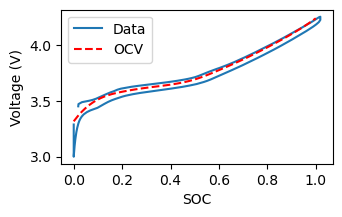
This yields a generally-good representation of the OCV.
Instantaneous Resistance (R0) Extractor#
The R0Extractor estimates the instantaneous resistance in the battery as a function of SOC from current steps observed in the current-voltage-time data.
We need to load a CellDataset that contains such details to demonstrate the usage of the extractor. In this case, we use a simulated dataset that represents a hybrid pulse power characterization test commonly used for electric vehicles.
[12]:
data = BatteryDataset.from_hdf('files/hppc.h5')
data.tables['raw_data']['state'] = data.tables['raw_data']['state'].str.decode('utf-8')
First, we visualize the simulated data:
[13]:
fig, axs = plt.subplots(2, 1, figsize=(3.5, 3.), sharex=True)
raw_data = data.tables['raw_data']
time = (raw_data['test_time'] - raw_data['test_time'].min()) / 3600
axs[0].plot(time, raw_data['voltage'])
axs[0].set_ylabel('Voltage (V)')
axs[1].plot(time, raw_data['current'])
axs[1].set_ylabel('Current (A)')
axs[1].set_xlabel('Time (hr)')
[13]:
Text(0.5, 0, 'Time (hr)')
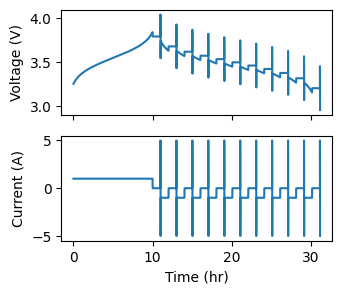
Now we employ the extractor to identify the current steps observed in the raw data and estimate the resistance as a function of SOC. The extractor takes as input an optional parameter, dt_max, that determines the maximum allowable timestep for the computation of the R0. We set this to 11 seconds, as the data collection frequency for the dataset is 10 seconds. In real applications, a much smaller dt_max is recommended.
[14]:
from moirae.extractors.ecm import R0Extractor
ext = R0Extractor(capacity=10, dt_max=11)
r0 = ext.extract(data)
[15]:
fig, ax = plt.subplots(figsize=(3.5, 2.))
soc = np.linspace(0, 1, 64)
fit = r0.get_value(soc)
ax.plot(soc, 0.05*np.ones(soc.shape), 'b-', label='ground truth')
ax.plot(soc, fit[0, :], 'r--', label='fit')
ax.set_ylabel('R0 (Ohms)')
ax.set_xlabel('SOC')
ax.set_xlim(0, 1)
ax.set_ylim(0, 0.07)
ax.legend()
[15]:
<matplotlib.legend.Legend at 0x74e1201ec4c0>
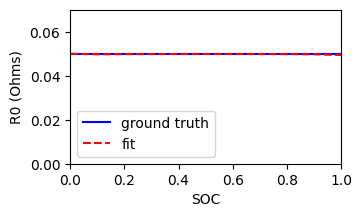
The extracted R0 is close to the ground truth, with less than 1% error across the SOC range.
Resistor-Capacitor (RC) Couple Extractor#
The RCExtractor estimates the parameters of the RC couples as a function of SOC from post-discharge or charge rests observed in the current-voltage-time data.
We will load a version of the HPPC dataset used for the previous example that contains a single RC pair and higher sampling rate.
[16]:
data = BatteryDataset.from_hdf('files/hppc_1rc.h5')
data.tables['raw_data']['state'] = data.tables['raw_data']['state'].str.decode('utf-8')
First, we visualize the simulated data:
[17]:
fig, axs = plt.subplots(2, 1, figsize=(3.5, 3.), sharex=True)
raw_data = data.tables['raw_data']
time = (raw_data['test_time'] - raw_data['test_time'].min()) / 3600
axs[0].plot(time, raw_data['voltage'])
axs[0].set_ylabel('Voltage (V)')
axs[1].plot(time, raw_data['current'])
axs[1].set_ylabel('Current (A)')
axs[1].set_xlabel('Time (hr)')
fig, ax = plt.subplots(figsize=(3.5, 2.))
ax.plot(time.iloc[50000:52000], raw_data['voltage'].iloc[50000:52000])
ax.set_ylabel('Voltage (V)')
ax.set_xlabel('Time (hrs)')
[17]:
Text(0.5, 0, 'Time (hrs)')
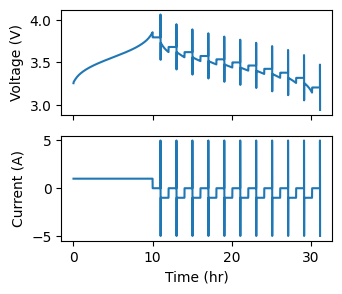
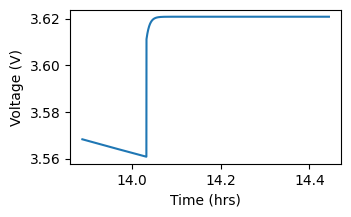
Now we employ the extractor to identify the relevant rests observed in the raw data and estimate the RC parameters as a function of SOC.
[18]:
from moirae.extractors.ecm import RCExtractor
from battdat.postprocess.integral import StateOfCharge, CapacityPerCycle
ext = RCExtractor(capacity=10)
StateOfCharge().enhance(data.tables['raw_data'])
rc = ext.extract(data)
[19]:
fig, axs = plt.subplots(2, 1, figsize=(3.5, 4.))
soc = np.linspace(0, 1, 64)
fit = rc[0].get_value(soc)
axs[0].plot(soc, 0.01*np.ones(soc.shape), 'b-', label='ground truth')
axs[0].plot(soc, np.squeeze(fit[0]), 'r--', label='fit')
axs[0].set_ylabel('R (Ohms)')
axs[0].set_xlabel('SOC')
axs[0].set_xlim(0, 1)
axs[0].set_ylim(0, 0.013)
axs[0].legend()
axs[1].plot(soc, 2500*np.ones(soc.shape), 'b-')
axs[1].plot(soc, np.squeeze(fit[1]), 'r--')
axs[1].set_ylabel('F (Farads)')
axs[1].set_xlabel('SOC')
axs[1].set_xlim(0, 1)
axs[1].set_ylim(0, 3000)
[19]:
(0.0, 3000.0)
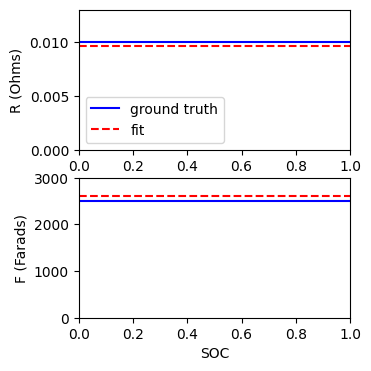
[ ]: